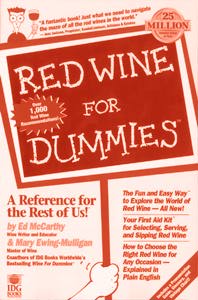Real (Vi)no-Brainer
Reviewed by Christina Waters
First there was Wine for Dummies, in which knowledgeable wine educators Ed McCarthy and Mary Ewing-Mulligan patiently and pithily demystified the rock-bottom basics of oenology (the study of wine). For those now able to tell the difference between France and California, or (and this is tougher) between wines of light and dark coloration, a new, more advanced member of the "IDG Books for Dummies" series has just been released. Red Wine for Dummies, also by McCarthy and Ewing-Mulligan is a breezy, easy-access primer to the increasingly fashionable world of vin rouge , the wine that fueled the infamous French paradox.
Educating readers on different grape varieties (e.g. merlot, pinot noir, cabernet) and winemaking regions (like Napa, Burgundy, Piedmont) this paperback page-turner excels in encouraging exploration, making recommendations and basically holding the reader's hand the whole way through.
Red Wine provides some rather sophisticated knowledge from time to time, talking us through subtle distinctions among tannin levels, nose and length of finish, for example. But the essential wine-appreciation focus lies in identifying and articulating common sense distinctions. A pull-out card at the front of the book is divided into an "If You Want A..." (say, "crisp, light-bodied red wine") column and a corresponding "Try ..." column, in which easily available wines are matched up with reader tastes. Beaujolais for example, is suggested as a light wine possibility, while barolo and châteauneuf-du-pape are suggested as full-bodied wines.
The authors educate on several levels. Readers are invited to build a broader vocabulary of tastes by examining their own tastes, needs and responses. Handy chapters like "Ten Hands-On Wine Tasting Exercises" and "Ten Little-Known Red Wines Worth Knowing" help build confidence. McCarthy and Ewing-Mulligan also construct a crisp, flab-free road map through the maze of bordeaux and brunellos, as well as tougher distinctions like "structure" and "flavor."
The whole tone is more Seinfeld than Wine Spectator. "Because red wines do have tannin and white wines generally don't," the authors tell us, "red wines are structurally more complex than white wines. In other words, a lot is happening in your mouth when you taste a red wine." See, that actually helps. The whole book does.
Despite the title, these briskly organized pages contain substantial information for all but the most experienced wine enthusiasts about how climate, skin contact (the grapes' not the drinkers'), soil, temperature and chemistry collaborate to create great wines. The lion's share gives a well-focused "big picture" of major grape types and then launches into separate chapters on the major winemaking regions. California and France get lots of room, naturally, but there's plenty of up-to-date info on emerging areas like Oregon and Washington, New Zealand and Chile.
With a brief glossary, home wine-tasting tips in the back and enough detail about lesser-known regions like Languedoc-Roussillon and Rioja to help empower the inquiring wine lover, Wine for Dummies seems destined to jump-start a whole new generation of confirmed vinophiles. And yes, there is a White Wine for Dummies, too.
This page was designed and created by the Boulevards team.

The inability to articulate the difference between a merlot and a meerkat is all you need to appreciate this low-tech wine guide
Red Wine for Dummies
Written by Ed McCarthy and Mary Ewing-Mulligan
IDG Books Worldwide, Inc.; 1996; $12.99.
From the November 21-27, 1996 issue of Metro Santa Cruz
Copyright © 1996 Metro Publishing, Inc.
![[MetroActive Books]](/books/gifs/books468.gif)